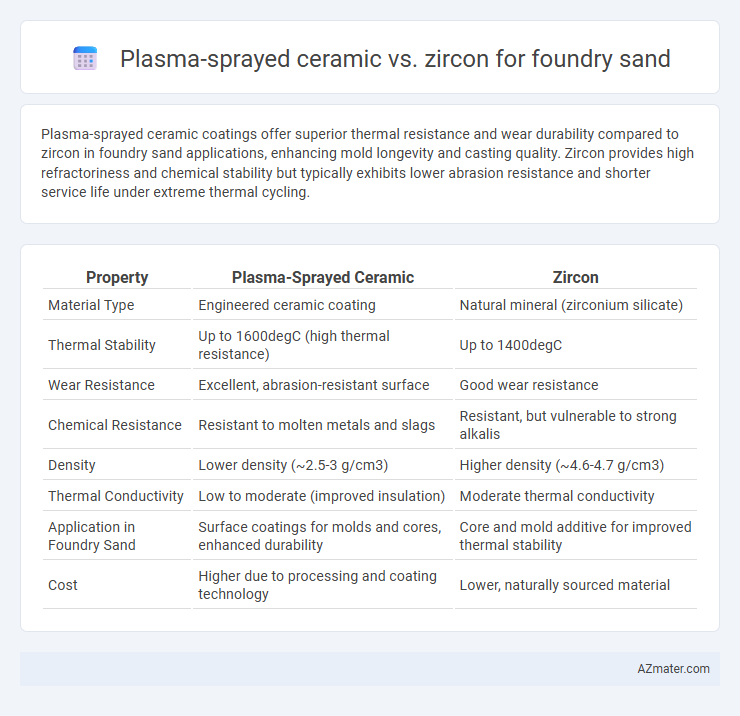Plasma-sprayed ceramic coatings offer superior thermal resistance and wear durability compared to zircon in foundry sand applications, enhancing mold longevity and casting quality. Zircon provides high refractoriness and chemical stability but typically exhibits lower abrasion resistance and shorter service life under extreme thermal cycling.
Table of Comparison
| Property | Plasma-Sprayed Ceramic | Zircon |
|---|---|---|
| Material Type | Engineered ceramic coating | Natural mineral (zirconium silicate) |
| Thermal Stability | Up to 1600degC (high thermal resistance) | Up to 1400degC |
| Wear Resistance | Excellent, abrasion-resistant surface | Good wear resistance |
| Chemical Resistance | Resistant to molten metals and slags | Resistant, but vulnerable to strong alkalis |
| Density | Lower density (~2.5-3 g/cm3) | Higher density (~4.6-4.7 g/cm3) |
| Thermal Conductivity | Low to moderate (improved insulation) | Moderate thermal conductivity |
| Application in Foundry Sand | Surface coatings for molds and cores, enhanced durability | Core and mold additive for improved thermal stability |
| Cost | Higher due to processing and coating technology | Lower, naturally sourced material |
Introduction to Foundry Sand Materials
Foundry sand materials are critical in metal casting processes, with plasma-sprayed ceramics and zircon being prominent options. Plasma-sprayed ceramic coatings offer excellent thermal insulation and wear resistance, enhancing mold durability in high-temperature environments. Zircon, known for its high thermal stability and low thermal expansion, provides superior refractory properties and surface finish in foundry sand applications.
Overview of Plasma-Sprayed Ceramic Sand
Plasma-sprayed ceramic sand offers enhanced thermal resistance and wear durability compared to conventional foundry sands, making it ideal for high-temperature casting processes. Its fine particle size and controlled composition improve mold surface finish and reduce defects in metal castings. This advanced material provides superior refractoriness and mechanical strength, outperforming traditional zircon sand in critical foundry applications.
Properties of Zircon as Foundry Sand
Zircon as foundry sand exhibits exceptional thermal stability and high refractoriness, making it ideal for high-temperature casting processes. Its low thermal expansion coefficient minimizes mold cracking, while its high density and chemical inertness ensure superior strength and resistance to slag penetration during metal pouring. Compared to plasma-sprayed ceramic coatings, zircon's natural composition offers enhanced durability and better surface finish quality in precision casting applications.
Comparison of Thermal Stability
Plasma-sprayed ceramic coatings exhibit superior thermal stability compared to zircon in foundry sand applications, withstanding temperatures above 1500degC without significant degradation. Zircon maintains good thermal resistance up to approximately 1300degC but tends to undergo phase transformations and structural changes beyond this point, reducing its effectiveness. The enhanced thermal stability of plasma-sprayed ceramics ensures longer mold life and improved dimensional accuracy in high-temperature casting processes.
Chemical Resistance in Casting Environments
Plasma-sprayed ceramic coatings exhibit superior chemical resistance compared to zircon when used as a protective layer in foundry sand applications, effectively withstanding aggressive slags and molten metal interactions. Zircon, while offering good thermal stability and moderate chemical resistance, is more susceptible to degradation in highly acidic or basic casting environments. The enhanced durability of plasma-sprayed ceramics reduces contamination risks and extends mold life, improving casting quality and operational efficiency.
Particle Shape and Flowability Analysis
Plasma-sprayed ceramic particles exhibit a more spherical shape compared to the angular morphology of zircon particles, enhancing their flowability in foundry sand applications. The spherical geometry of plasma-sprayed ceramics reduces inter-particle friction and promotes better packing density, resulting in improved mold stability and surface finish. Flowability analysis consistently shows higher flow rates and lower cohesive forces for plasma-sprayed ceramics, making them superior for uniform sand distribution in precision casting processes.
Cost Efficiency and Material Availability
Plasma-sprayed ceramic coatings offer high durability but involve significant upfront equipment and operational costs, making them less cost-efficient compared to zircon-based foundry sands commonly used for their balance of price and performance. Zircon, abundant in mineral sands with well-established supply chains, ensures consistent material availability and cost-effectiveness crucial for large-scale foundry applications. The high thermal resistance and stability of plasma-sprayed ceramics may justify their investment in specialized processes, but zircon remains the preferred choice where cost efficiency and reliable sourcing are primary concerns.
Environmental Considerations and Recycling
Plasma-sprayed ceramic coatings on foundry sand offer enhanced thermal resistance and durability, reducing the frequency of sand replacement and minimizing waste generation compared to traditional zircon sands. Zircon, while naturally occurring and recyclable, often undergoes intensive mining processes that contribute to environmental degradation and energy consumption. Recycling plasma-sprayed ceramics remains challenging due to bonding agents, whereas zircon sands can be efficiently reclaimed and reused in multiple casting cycles, promoting a more sustainable foundry operation.
Performance in Complex Casting Applications
Plasma-sprayed ceramic coatings exhibit superior thermal stability, abrasion resistance, and chemical inertness compared to zircon when used as foundry sand in complex casting applications. Zircon offers high refractoriness and thermal shock resistance but can degrade under prolonged exposure to extreme temperatures and reactive metal alloys. Consequently, plasma-sprayed ceramics enhance mold longevity and casting precision by maintaining structural integrity and minimizing defects in intricate geometries.
Conclusion: Choosing the Optimal Foundry Sand
Plasma-sprayed ceramic coatings offer enhanced thermal resistance and durability compared to traditional zircon foundry sand, making them suitable for high-temperature applications. Zircon provides superior refractory properties and cost-effectiveness, which benefits large-scale casting operations. Selecting the optimal foundry sand depends on balancing performance requirements, thermal stability, and budget constraints for specific foundry processes.

Infographic: Plasma-sprayed ceramic vs Zircon for Foundry sand
 azmater.com
azmater.com